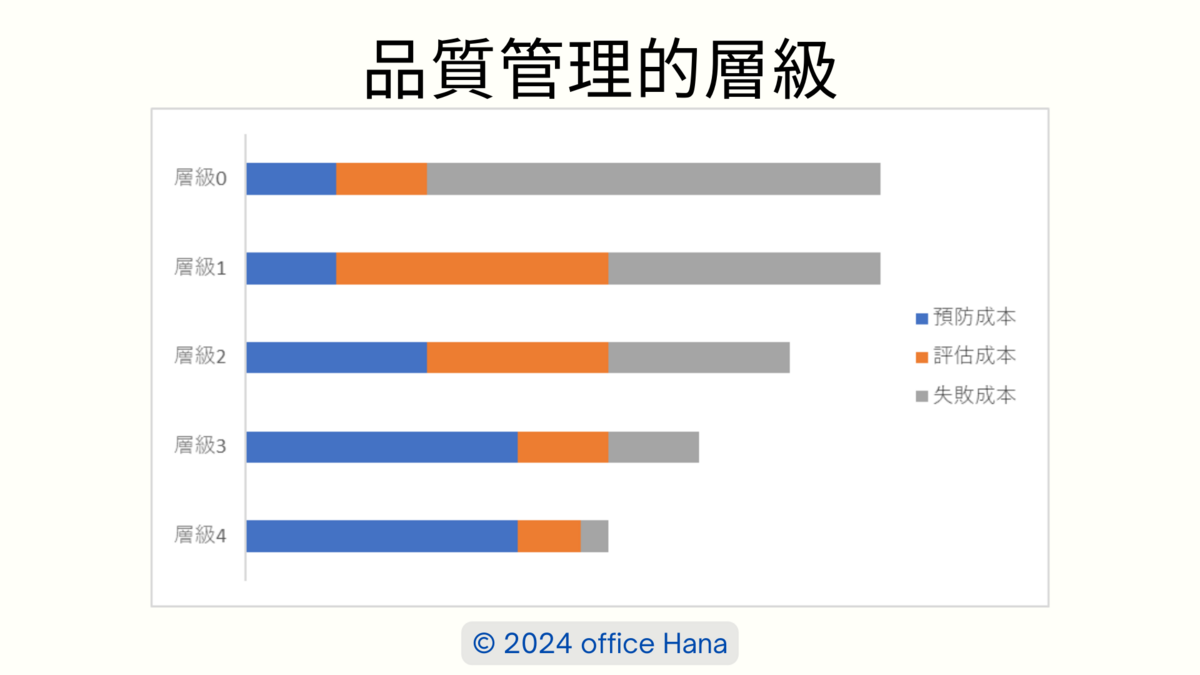伊藤庵的自我介紹部落格連結
Listed in English, Formosan, and Japanese in that order.
Please note that this is an automatic translation.
按順序列出了英語、台灣語和日語。
請注意,這是自動翻譯。
日本語は最後にあります。

Levels of Quality Management
Are you, as a small business owner, grappling with challenges related to quality management? Enhancing the level of quality management not only maintains the quality of products and services but also significantly contributes to cost reduction and profit enhancement across the company. In this article, we will explain the various levels of quality management and propose specific improvement strategies for each stage.
To summarize, incrementally elevating the levels of quality management can help small businesses reduce costs associated with quality issues and ultimately increase profits. To effectively advance quality management, it is crucial to implement appropriate measures tailored to each level.
Level 0 and Level 1 of Quality Management
At Level 0, the goal is "to avoid inconveniencing the customer." The initial focus is on minimizing the occurrence of defective products that reach customers. As you move to Level 1, the emphasis shifts to preventing disruptions in subsequent processes. This means reducing the incidence of defects within internal processes to minimize their impact on other departments within the company.
Level 2 - Stable Quality Management
Reaching Level 2 indicates that quality has stabilized, and company-wide efforts to reduce defects are in place. At this stage, Statistical Quality Control (SQC) is utilized to minimize quality variations. However, there are limitations to SQC, and advancing to higher levels requires a change in approach.
Level 3 - Substantial Reforms
Level 3 calls for substantial reforms. Key areas of focus include strengthening management capabilities, achieving self-sustained reform, enhancing reliability, improving management efficiency, and developing new technologies. Specifically, this involves revisiting management systems and adopting new technologies to further improve quality.
Level 4 - Ideal State
Ultimately, reaching Level 4 involves considering the reduction of Prevention Costs (P Costs) and Appraisal Costs (A Costs). At this level, quality management is fully entrenched, and continuous improvement becomes the norm. Specific measures include advancing quality management systems and implementing more efficient process management.
By undertaking concrete measures aligned with each level of quality management, small businesses can reduce costs associated with quality issues and increase profits. Quality management is not merely a cost-saving tool but a vital component that contributes to overall efficiency and sound management. Small business owners, let's take specific steps to elevate the level of quality management and maximize profits. Improving the levels of quality management is the key to a brighter future for your company.
品質管理的等級
身為小型企業的經營者,您是否正為品質管理相關的挑戰而苦惱?提升品質管理的等級,不僅能維持產品和服務的品質,還能大幅度降低成本並提高公司的利潤。在本文中,我們將解釋品質管理的各個等級,並針對每個階段提出具體的改進策略。
簡而言之,逐步提升品質管理的等級可以幫助小型企業減少與品質問題相關的成本,並最終增加利潤。為了有效推進品質管理,必須針對每個等級實施適當的措施。
品質管理的等級0和等級1
在等級0,目標是「避免給顧客帶來不便」。首先要集中精力將到達顧客的次品減少到最少。當進入等級1時,重點轉向防止後續工序的中斷。這意味著要減少內部流程中的缺陷,以盡量減少對公司內其他部門的影響。
等級2 - 穩定的品質管理
達到等級2表示品質已經穩定,並且公司內部全員參與的減少缺陷活動已經展開。在這個階段,運用統計品質控制(SQC)來減少品質的變異。然而,SQC有其局限性,進一步提升等級需要改變方法。
等級3 - 實質性改革
等級3要求實質性的改革。關鍵領域包括加強管理能力、實現自我改革、提高可靠性、改進管理效率和開發新技術。具體來說,這涉及重新審視管理系統並採用新技術以進一步提升品質。
等級4 - 理想狀態
最終,達到等級4需要考慮降低預防成本(P成本)和評價成本(A成本)。在這個等級,品質管理完全紮根,持續改進成為常態。具體措施包括提升品質管理系統和實施更高效的流程管理。
通過針對每個品質管理等級採取具體的措施,小型企業可以減少與品質問題相關的成本並增加利潤。品質管理不僅僅是節省成本的工具,它是促進整體效率和健全管理的重要組成部分。小型企業經營者們,讓我們採取具體步驟提升品質管理等級,最大化利潤。提升品質管理的等級是讓您的公司擁有更光明未來的關鍵。
品質管理のレベル
中小企業の経営者の皆さん、品質管理に関する課題で頭を悩ませていませんか?品質管理のレベルを向上させることは、単に製品やサービスの品質を保つだけでなく、会社全体のコスト削減や利益向上に大きく寄与します。今回は、品質管理の各レベルについて説明し、それぞれの段階での具体的な改善策を提案します。
結論から言うと、品質管理のレベルを段階的に上げていくことで、中小企業は品質問題に起因するコストを削減し、結果として利益を増加させることができます。品質管理を効果的に進めるためには、各レベルに応じた取り組みを適切に行うことが重要です。
品質管理のレベル0と1
レベル0では、「とにかくお客様に迷惑をかけないこと」が目標です。まずは顧客に対する不良品の発生を最小限に抑えることから始めます。レベル1に進むと、後工程に迷惑をかけないことが重要となります。つまり、内部のプロセスでの不良品の発生を抑え、社内の他部門への影響を最小限にすることが求められます。
レベル2 - 安定した品質管理
レベル2に達すると、品質は安定し、全員参加による不良低減活動が行われます。ここでは、統計的品質管理(SQC)を活用して、品質のばらつきを減らす取り組みが行われます。しかし、統計的品質管理には限界があり、さらなるレベルアップには発想の転換が必要です。
レベル3 - 実質的な改革
レベル3では、実質的な改革が求められます。ここでは、マネジメント力の強化、改革の自立化、信頼性向上、管理の効率化、新技術開発などが重視されます。具体的には、管理システムの見直しや、新しい技術を取り入れることで品質をさらに向上させることが目標です。
レベル4 - 理想的な状態
最終的に、レベル4に到達すると、予防コスト(Pコスト)や評価コスト(Aコスト)の圧縮が検討されます。このレベルでは、品質管理が完全に定着し、持続的に改善が行われる状態を目指します。具体的な施策としては、品質管理システムの高度化や、さらに効率的なプロセス管理が挙げられます。
品質管理の各レベルに応じた具体的な取り組みを行うことで、中小企業は品質問題に起因するコストを削減し、利益を増加させることができます。品質管理は単なるコスト削減の手段ではなく、会社全体の効率化と健全な経営に寄与する重要な要素です。中小企業の経営者の皆さん、品質管理のレベルを上げ、利益を最大化するための具体的なステップを踏み出しましょう。品質管理のレベルを向上させることは、会社の未来をより明るいものにするための鍵となります。
office Hana An / 小庵
Quality Consultant / 品質顧問 / 品質コンサルタント
I have been involved in hardware design for electrical products for 20 years and have provided quality control guidance for electrical components for 10 years.
Through quality control guidance, manufacturing process audits, and support in problem-solving, I lead clients' businesses to growth.
我從事電子產品硬體設計已有 20 年,並且擔任電氣元件品質控制指導已有 10 年。
透過品質控制指導、製造流程審核和問題解決支援等方式,我引導客戶的業務成長。
私は電気製品のハードウェア設計を20年、電気部品の品質管理指導を10年行ってきました。
品質管理の指導、製造工程の監査、問題解決のサポートなどによりクライアントのビジネスを成長に導きます。